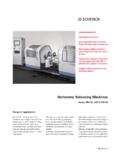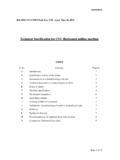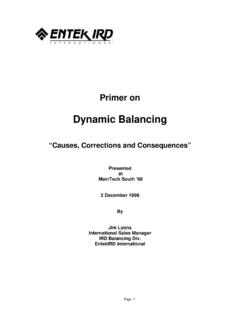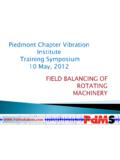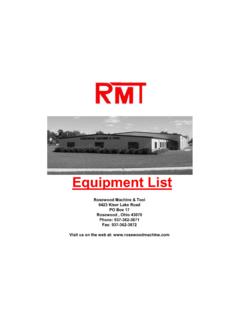Transcription of A Brief Tutorial on Machine Vibration
1 A Brief Tutorial on Machine Vibration byVictor Wowk, Dynamics, purpose of this Tutorial is to provide sufficient knowledge to understand Machine Vibration diagnosis. You may be tasked with solving a Vibration problem, or you may be overseeing someone else and you need to understand the process. This Tutorial discusses the symptoms, taking measurements, analyzing the data, additional testing, understanding the physics, and finally, fixing the problem. It provides practical information that has proven useful over several decades in correcting all types of Machine Vibration problems, with a few tenacious exceptions. There are usually several technical solutions to any Vibration problem, and thistutorial will guide you through the first step is to understand the problem from its outward symptoms. This means observation and measurements to quantify the symptoms, and then analysis to interpret the data.
2 It is usually best to proceed from a position of knowledge while deflating opinions that are not supported by the data. The diagnosis is the shorter part of the journey, taking one person several hours to accomplish, but is the most important part becauserecommendations here will commit many persons and many hours to remedial work. We would like the correction to be successful on the first Vibration is not bad. Machines produce some oscillatory motion as part of their normal operation andthese are nothing to be concerned about. I call these benign vibrations and here are some examples: 120-Hz motor hum blade passing frequency pure tones from motors, especially those driven by VFD s broadband turbulence from fluid-handling machines, like fans and pumps gearmesh frequenciesThese benign vibrations are characteristic of regular operation of a Machine doing what it is supposed to do.
3 The amplitudes will vary from Machine to Machine and are a measure of the quality of manufacturing and load condition. The presence of these benign vibrations at normal levels provides a comfortable feeling that the Machine is still alive. A change above normal levels not explained by a corresponding load change is reasonfor investigation, but not alarm. Serious Vibration are: 1x-rpm amplitudes above the balance limits in Table 1. shock pulses large shaking motion abnormal noiseThese serious vibrations will cause accelerated wear and premature failure. They should be acknowledged as damaging and addressed with some corrective first task for the Vibration analyst is to obtain frequency selective amplitude data to identify the source of Vibration . The frequency is the key information that establishes the possible causes and then the amplitude is used to judge the severity.
4 This means having a Vibration analyzer at one s disposal. More on this in the section Instruments and Methods. This takes us to the first fork in the analysis flowchart, Figure 1. ThePage 1appropriate question to ask when armed with the frequency and amplitude data is whether the Vibration is benign or serious. If it is benign, then we can safely ignore it. It may, however, cause concern for a sensitive occupant nearby by virtue of transmitting to that space and interfering with that process. An example is a rooftop fan that shakes a delicate optical microscope below. In this case the fan may be but we need to treat the path of Vibration . The corrective action to take for benign vibrations that are not bothering anyone is toexplain this to those concerned, and perhaps monitor this Vibration for a time to verify that it is not trending upward in the Vibration is deemed to be serious, then this takes us to the second fork in the flowchart forced versus natural Vibration .
5 This requires additional testing; usually stopping the Machine to do resonance testing, avisual inspection, cleaning if necessary, and runout measurements with a dial indicator. The reason for determining early whether the Vibration is forced or natural is because the fixes are completely different. Forcedvibrations on machines are corrected by mass balancing, aligning, or changing the bad parts. Natural vibrations are a structural effect, where some structure behaves like a mechanical amplifier that is frequency sensitive. Thesymptoms of natural vibrations, or resonance, Vibration is very bad, in other words, abnormally high Vibration is strongly amplitude is not steady, but varies up and during runup or coastdown as harmonics pass through the natural a resonance is suspected from the symptoms, then it needs to be verified with some additional tests.
6 These resonance tests are:Page 2 Figure 1. Vibration testing of the major components to find their natural or deflection shapesThese tests require specialized equipment and methods to obtain valid results. For example, Tests 1 and 2 are done with the Machine stopped using an instrumented hammer or a electrodynamic shaker with a power amplifier. Test 3 requires recording the data and Test 4 is done during normal operation taking amplitude, and perhaps phase, measurements along a grid pattern. The positive outcome of this is that during the testing a corrective fix usually becomes obvious. The five known fixes for resonance the natural frequency of the responding part with added mass or the source Vibration absorber Table 1. Vibration LimitsVibration LimitsBalance ConditionDisplacement, milsPeak to Peakat 1x rpmOverall Velocityin/sec Peak10 - 1,000 HzOverall Acceleration, gPeak0 - 5,000 HzElectric Motors1,000 - 2,000 > 2,000 Fans< 600 -1,000 ,000 2,000 > 2,000 EnginesGas or 3 These fixes are very different from the balancing, alignment, or changing parts for forced vibrations, so it is important to identify this fork in the road before proceeding down the wrong is AcceptableTable 1 is a general guide for acceptable Vibration on many classes of common machines.
7 This table wascompiled from industry standards, some published specifications, from manufacturers factory balance levels on new equipment, and from field experience. These limits apply for measurements at, or as close as safely possible to, the bearings. These guidelines are general in that they are economically achievable and Vibration below these levels will allow the Machine to survive a normal life in service. These levels may need to be reduced for product-quality purposes, or for stealthiness in military applications. The levels may need to be allowed to float above these levels for flexible-mounting conditions, such as springs or elevated platforms. Higher levels may also need to be allowed when higher- Vibration sources are nearby. An example is a diesel engine driving a gearbox and a high-speed pump, all on the same common skid base.
8 The gearbox and pump Vibration may not meet their specified levels because of the thumping from the engine, but all three machines may be to operate as and methodsA Vibration measuring instrument separates the frequencies and quantifies the amplitude, Figure 2. It converts the physical motion into an electrical signal that can be further processed and displayed along a frequency axis. It provides us with the big picture of Vibration by identifying the specific causes with the frequency and judging acceptability with the amplitude. There are three major categories of Vibration instruments, each of which can use a velocity transducer or accelerometer as the simplest, and least expensive, is an overall meter. It provides no frequency information, onlyoverall amplitudes, so it is useless for analysis.
9 It is useful for trending or comparison measurements on similar machines, but for diagnosing problems on machines it is best left turned 4 Figure 2. An FFT SpectrumThe other two major Vibration instruments are tuneable filters and FFT (Fast Fourier Transform) analyzers. Analyzer is a misnomer because analysis is a human function. An electronic analyzer does no analysis. It only measures and display electrical signals. The electrical signals from accelerometers and velocitytransducers are very small AC voltages, typically millivolts. Hence, the tuneable filters and FFT instruments arenothing more than fancy AC voltmeters with a frequency display axis. Vibration instruments have been grossly oversold in the past two decades under the guise of computer intelligence. Any of these two major Vibration measuring instruments, from any manufacturer, can be used effectively to diagnose Machine vibrations.
10 No specific instrument or manufacturer has a unique connection to a higher intelligence. However, some are an order of magnitude or two more complicated to use by design. The instrument in use is the least significant factor in diagnosis. The instrument operator and the methods employed are the most fundamental method of using a Vibration instrument is to conduct a survey of the entire Machine system; driver, driven, and any intermediary machines such as gearboxes. The purpose of this survey is to map out the entire system at least once so as not to overlook anything before diving into details. Calmly, and objectively, gather the numbers in tabular form to be able to view it all in one image. Table 2 is a sample form. Table 2. Vibration Survey FormEquipmentDisplacement Mils, peak-to-peak Filtered to 1xRPMO verall VelocityIn/sec, RMS10-1,000 HzOverall Accelerationg/ peak0 5,000 HzMotorODEH orizontalVerticalAxialDEHorizontalVertic alAxialPumpDEHorizontalVerticalAxialODEH orizontalVerticalAxialThe first column measures the balance condition.
